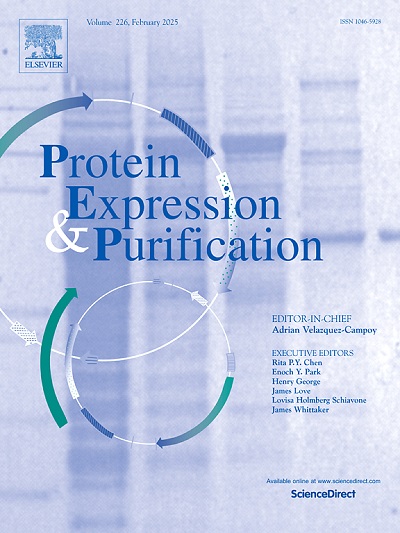Sf9昆虫细胞中人udp -葡萄糖糖蛋白-葡萄糖基转移酶-硒蛋白F复合物的表达、纯化和酶学特性
IF 1.2
4区 生物学
Q4 BIOCHEMICAL RESEARCH METHODS
引用次数: 0
摘要
内质网糖蛋白质量控制系统的正常运作对维持细胞稳态至关重要。糖蛋白葡萄糖基转移酶1 (UGGT1)是该系统的关键组成部分,通过识别同源糖蛋白的部分折叠状态并将其去糖基化的n -聚糖重新糖基化,起到“折叠传感器”的作用。值得注意的是,已知UGGT1与硒蛋白F (SelenoF)形成异源二聚体,尽管复合物形成的机制尚不清楚。迄今为止,还没有关于重组人ugt1大规模表达系统的报道,也没有在体外证明人ugt1 - selenof复合物的形成。为了解决这一问题,我们利用基于昆虫细胞的表达系统对人ugt1和SelenoF进行了异源表达,获得了比大肠杆菌表达系统更高的纯度和效率。重要的是,独立制备的两种蛋白在体外可以形成复合物。人类ugt1和UGGT1- selenof配合物规模化生产体系的建立,为进一步研究其结构特征和动力学行为奠定了基础。本文章由计算机程序翻译,如有差异,请以英文原文为准。
Expression, purification, and enzymatic characterization of human UDP-glucose:glycoprotein glucosyltransferase-selenoprotein F complex from Sf9 insect cells
Appropriate functioning of the glycoprotein quality control system in the endoplasmic reticulum is crucial for maintaining cellular homeostasis. UDP-glucose:glycoprotein glucosyltransferase 1 (UGGT1) is a key component of this system, serving as a “folding sensor" by recognizing the partially folded state of cognate glycoproteins and reglucosylating their deglucosylated N-glycans. Notably, UGGT1 is known to form heterodimers with Selenoprotein F (SelenoF), although the mechanism underlying the complex formation remains unclear. To date, there have been no reports of large-scale expression systems for recombinant human UGGT1, and the formation of the human UGGT1-SelenoF complex has not been demonstrated in vitro. To address this, we used an insect cell-based expression system for heterologous expression of human UGGT1 and SelenoF, achieving high purity and efficiency superior to that of Escherichia coli expression systems. Importantly, the two proteins, prepared independently, were observed to form complexes in vitro. The establishment of a system for large-scale production of human UGGT1 and UGGT1-SelenoF complexes paves the way for future studies investigating their structural characteristics and dynamic behavior.
求助全文
通过发布文献求助,成功后即可免费获取论文全文。
去求助
来源期刊

Protein expression and purification
生物-生化研究方法
CiteScore
3.70
自引率
6.20%
发文量
120
审稿时长
32 days
期刊介绍:
Protein Expression and Purification is an international journal providing a forum for the dissemination of new information on protein expression, extraction, purification, characterization, and/or applications using conventional biochemical and/or modern molecular biological approaches and methods, which are of broad interest to the field. The journal does not typically publish repetitive examples of protein expression and purification involving standard, well-established, methods. However, exceptions might include studies on important and/or difficult to express and/or purify proteins and/or studies that include extensive protein characterization, which provide new, previously unpublished information.
 求助内容:
求助内容: 应助结果提醒方式:
应助结果提醒方式:


